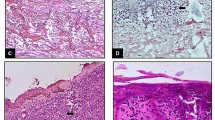Abstract
The influence of postmortem damage of tissues on the immunohistochemical diagnosis of wound age has not as yet been clarified. We utilized antibodies against the proteinase inhibitors α-1-antichymotrypsin and α-2-macroglobulin, fibronectin and lysozyme to study samples of skin which had been intact intravitally, but were damaged postmortem either by autolysis or compression with a surgical clamp at the time of dissection. Even in the absence of autolysis, antibodies against the proteinase inhibitors and fibronectin exhibited staining of tissue margins. Autolysis caused an increase in false positive results. In contrast, antibodies against lysozyme did not give false positive staining. There were no antigens sensitive to postmortem clamping and false positive results were not observed. Antibodies against proteinase inhibitors are not useful for the diagnosis of wound age because of a high number of false positive reactions in marginal areas. Fibronectin also showed false positive band-shaped staining patterns at the tissue margin. In addition, autolytic processes increase the number of false positives. The antibody against lysozyme is much less sensitive to autolysis and no false positive reactions were observed in our series of tests.
Similar content being viewed by others
References
Betz P, Nerlich A, Wilske J, Tübel J, Wiest I, Penning R, Eisenmenger W (1992) Immunohistochemical localisation of fibronectin as a tool for the age determination of human skin wounds. Int J Legal Med 105:21–26
Betz P, Nerlich A, Wilske J, Tübel J, Penning R, Eisenmenger W (1993a) The immunohistochemical localisation of alpha-1-antichymotrypsin and fibronectin and its meaning for the determination of the vitality of human skin wounds. Int J Legal Med 105:223–227
Betz P, Nerlich A, Wilske J, Tübel J, Penning R, Eisenmenger W (1993b) The immunohistochemical analysis of fibronectin, collagen type III, laminin, and cytokeratin 5 in putrified skin. Forensic Sci Int 61:35–42
Betz P, Tübel J, Eisenmenger W (1995) Immunohistochemical analysis of markers for different macrophage phenotypes and their use for a forensic wound age estimation. Int J Legal Med 107:197–200
Fechner G, Bajanowski Th, Brinkmann B (1993) Immunohistochemical alterations after muscle trauma. Int J Legal Med 105:203–207
Fieguth A, Kleemann WJ, Tröger HD (1994) Immunohistochemical examination of skin wounds with antibodies against alpha-1-antichymotrypsin, alpha-2-macroglobulin and lysozyme. Int J Legal Med 107:29–33
Grinnell F, Billingham RE, Burgess L (1981) Distribution of fibronectin during wound healing in vivo. J Invest Dermatol 76:181–189
Hsu SM, Raine L, Fanger H (1981) Use of avidin-biotin-peroxidase complex (ABC) in immunoperoxidase techniques, a comparision between ABC and unlabeled antibody (PAP) procedures. J Histochem Cytochem 29:577–580
Kirkpatrick P, D'Ardenne AJ (1984) Effects of fixation and enzymatic digestion on the immunohistochemical demonstration of laminin and fibronectin in paraffin embedded tissue. J Clin Pathol 37:639–644
Oehmichen M (1990) Die Wundheilung. Theorie und Praxis der Chronomorphologie von Verletzungen in der forensischen Pathologie, Springer, Berlin Heidelberg, pp 15–16
Oehmichen M, Schmidt V, Stuka K (1989a) Freisetzung von Proteinase-Inhibitoren als vitale Reaktion im frühen posttraumatischen Interval. Z Rechtsmed 102:461–472
Oehmichen M, Schmidt V, Stuka K (1989b) Immunhistochemischer Vitalitätsnachweis von offenen Hautwunden am Paraffinschnitt. Beitr Gerichtl Med 4:7–11
Reid WA, Branch T, Thompson WD, Kay J (1987) The effect of diffusion on the immunolocalization of antigen. Histopathology 11:1277–1284
Reinhold-Richter L, Renner H (1991) Normale Kaninchenseren. Eine immunologische und immunhistologische Studie. Zentralbl Pathol 137:66–68
True LD (1990) Diagnostic immunhistopathology. Gower Medical, New York London, p 1.3
Schulz-Schaeffer WJ, Brück W, Püschel K (1996) Macophage subtyping in the determination of age of injection sites. Int J Legal Med 109:29–33
Viljanto J, Pentinnen R, Raekallio J (1981) Fibronectin in early phases of wound healing in children. Acta Chir Scand 147:7–13
Author information
Authors and Affiliations
Rights and permissions
About this article
Cite this article
Fieguth, A., Kleemann, W.J., von Wasielewski, R. et al. Influence of postmortem changes on immunohistochemical reactions in skin. Int J Leg Med 110, 18–21 (1997). https://doi.org/10.1007/BF02441020
Received:
Revised:
Issue Date:
DOI: https://doi.org/10.1007/BF02441020




